This week we look at the enduring genre of low-to-mid-budget action movies, with Liam Neeson on the poster … in a jacket … with a gun.
We examine their performance, economics, and why they continue to get made. And we finale with a Neeson/Statham/Butler smackdown to crown the king of the genre.
I first encountered Liam Neeson in the 1980s film Lamb. An incredibly moving and upsetting movie, with a soulful performance from Neeson, who plays a conflicted priest.
If you’d told me that 40 years later, he would be best known as an action star and still going in his 70s, it would have been hard to believe.
But following the seminal Taken in 2009, Neeson came to define a certain type of film: low-to-mid-budget action movies, with a middle-aged (increasingly, older) male lead, pursuing vengeance and/or clearing their name, normally with family relationships at stake. They tend to have “a particular set of skills, acquired over a long career”.
The holy trinity of these movies is: Liam Neeson, Jason Staham, and Gerard Butler. I think each represents a ‘franchise’ in their own right - put them in this genre, holding a gun on the poster, and you can expect the kind of brand recognition and affinity from their fanbase that is normally reserved for specific IP.
It is this promise that gets the movies greenlit. They are often stitched together with a combination of international presales, where foreign sales agents have enough confidence in the star and the genre to predict the value of the title in their territories at the box office and, importantly, ancillary windows. The budgets are usually sensible enough that they don’t have to do crazy numbers at the box office to generate a return - and when they do break out, the upside is significant.
Here is how they perform at the Box Office:
Further characteristics of these movies:
They are usually short - often 90 minutes, and all less than 2 hours
Budgets tend to be between $20m-$70m (the average across all titles analysed for this article was $36m)
They are better-received by fans than by critics
They over-index internationally (approx 60/40 in favour of International)
Although several of these titles have generated sequels and could be referred to as franchises, most have not attempted the kind of ‘universe expansion’ or commercial extensions that one might associate with true franchise IP, such as John Wick. The two exceptions to this are: Has Fallen, which was given a TV spinoff by StudioCanal (about to begin filming Season 2); and The Transporter, which had a TV series from 2012-14 and also an additional sequel without Statham, called The Transporter Refueled (which despite lacking Statham still took $70m worldwide on a $22m budget, slightly undermining my point that the star is the franchise…)
They also perform well on streaming:
In general, the whole action genre outperforms on streaming services - as
analyses in his latest (highly recommended) newsletter:
“action films (like actual action films with shootouts, car chases, and so on) dominate the streaming charts, making up nine of the top 25 films [of 2024]”
Indeed, Butler’s Den of Thieves 2: Pantera just debuted at No. 1 on Netflix in the US
In 2021 Neeson’s Ice Road sold to Netflix in a record $18m EFM domestic deal
Amazon Prime Video recently pre-bought most International territories on Neeson’s forthcoming action/chase movie Mongoose for $20M
Economics
The stars make good money on these movies - they can command fees of around $10 per film (The Hollywood Reporter recently reported that Jason Statham was set to receive a $10m fee for The Man From Toronto - a movie with Kevin Hart, which Statham ultimately exited). Liam Neeson was reportedly paid $5m for Taken, $15m for Taken 2 and $20m for Taken 3.
Even though these are not major, big-budget studio releases, the talent have good leverage when negotiating fees because they *are* the IP. I was involved with financing one such film (not one of the titles analysed here), where the star’s fee was higher than the rest of the production budget (a $10m fee for a total $18m budget, which is insane).
There is also backend. According to Variety, Butler’s contract for Olympus Has Fallen - revealed when he sued Nu Image/Millennium Films over his profit participation - entitled him to 10% of net profits, plus 6% of domestic adjusted gross receipts above $70 million and 12% of foreign adjusted gross receipts above $35 million. His production company was also entitled to 5% of net profits, and Butler was to receive certain bonuses for hitting box office thresholds. The case settled in Oct 2013 with Butler reportedly “satisfied”.
As some of the charts above show, Box Office results are not guaranteed. The performance of Neeson’s films in particular have tailed off in recent years. But the overall economic model is helped/de-risked by: i) carefully controlled budgets, ii) tax credits and location incentives, iii) presales in certain international territories, and iv) ancillary upside from streaming and TV sales.
Here is what Deadline reported when Liam Neeson’s Retribution was released in 2023:
This is the nth recent Neeson action film that’s coming in with an opening in the lower single digits after last year’s Marlowe ($1.8M), Memory ($3.1M), Blacklight ($3.5M) and 2021’s The Marksman ($3.1M). But get this, these movies are profitable or else they wouldn’t get made. “I wish I had a Liam Neeson action film,” drooled one foreign sales boss to me.
Retribution, made by StudioCanal and the Picture Company, was made for around $20M. Neeson gets a payday in the upper single digits. Lionsgate bought U.S. for $6M … and they keep the P&A low in the high single digit range. PVOD is where this movie overindexes. Between foreign sales and Lionsgate, that’s covering about $18M of the production cost. StudioCanal already has its own territories that they’re reaping box office and ancillaries off of with France, Germany, Australia, UK and Poland. Everyone comes out of the wash OK, I’m told by sources. For foreign sales folks and distributors, is being in business on a Neeson pic similar to that of a Nicolas Cage movie? “It’s better,” says another foreign sales exec.
The Wall Street Journal reported that when Open Road financed Liam Neeson’s The Marksman from the script stage:
they offset a chunk of its costs by selling rights to distribute the picture in foreign markets, a common financing strategy. After factoring in tax credits from states where it was shot, and other subsidies, The Marksman needed to gross an amount in the single-digit millions at theaters, according to Tom Ortenberg [head of Open Road Films], to get on a path to profitability. He says the next phase of the movie’s release—digital rentals and licensing to streaming platforms or television, where demand is high—will put the movie in the black
Even if the headline Box Office sometimes doesn’t look great, the overall economics are obviously working for the parties involved because they keep coming back from more: Code Entertainment produced Neeson’s Ice Road and are now back in business with him for the forthcoming Ice Road 2 and also Mongoose. The Solution Entertainment Group have made 5 movies with Neeson.
The Smackdown
To pit Neeson vs Statham vs Butler in a smackdown befitting the genre, we looked at the following datapoints for the titles included in our analysis:
Total Box Office
Average Box Office per title
Average critical reception
Average audience reception
Total Box Office divided by total budget (as a proxy for profitability)
Based on the rankings for the above datapoints we then allocated 1 point for a 1st place finish, 2 for 2nd, and 3 for 3rd, and totalled the points to arrive at an overall ranking
And the results are in:
The Future
Neeson has hinted in recent interviews that he might retire, telling People magazine:
“I’m 72 — it has to stop at some stage … Maybe the end of next year [2025]. I think that’s it.”
His IMDB ‘Coming Soon’ page tells a different story:
Jason Statham is filming a sequel to The Beekeper (his biggest hit from the films in our analysis). He also has a new movie out tomorrow (28th March 2025) with the same director - here is the poster at a London bus stop, taken yesterday. The script is by Sylvester Stallone, believe it or not.
Gerard Butler is making his 4th entry in the Has Fallen franchise, Night Has Fallen, as well as a sequel to Greenland, called Greenland: Migration, the worldwide rights to which sold at Cannes for $75m. Following the success of Den of Thieves: Pantera, a third movie in that franchise is also in the pipeline.
For as long as audiences want to see guys in suits using their special skills to beat people up, and as long as that economic model hangs together, these movies are going to keep coming.
I think there is a reason why these three stars are the top of this genre’s tree: they always bring something extra to the role, and rarely look like they’re going through the motions, even with the most pedestrian scripts. As Variety wrote reviewing Den of Thieves: Pantera:
Butler’s brusque, beady-eyed, scowling-hulk charisma has aged well. A quick-fire actor in a caveman’s body, he has the ability to lift a piece of pulp so it almost seems like a real movie.
Variety reviewing Liam Neeson’s Memory:
Through it all, Neeson remains a great actor, someone who seeks to understand the soul of such violent men, and that sets his projects apart from the countless other “Taken” knockoffs produced each year.
And finally, Variety reviewing Neeson’s Honest Thief:
It proves once again that Liam Neeson is an actor who will take a paycheck gig without treating it like one … Neeson delivers each low-down threat and underworld proposition as if it were Shakespeare. He’s got his towering full-boil fury, but behind it there’s that lingering controlled hint of Irish politeness. He’s saying, with every line, “I don’t want to raise my voice. I don’t want to smash your windpipe. You’re making me do this. Please, for your own sake, I’d advise you to stop.” … As an actor, Liam Neeson means everything he says. He’s the action star as alchemist, converting trash into…well, better trash.
That’s the actor I saw back in the ‘80s in Lamb, just using his special skills to a slightly different end.
Postscript: Methology
For this analysis we included titles with the following criteria:
Theatrically-released
The actor as lead or co-lead (which excludes ensemble movies and lower-billed roles - such as Jason Statham titles Lock Stock, Snatch, 13, The Italian Job, and The Expendables)
Budgets of under $100m (which excludes The A-Team for Liam Neeson; The Fate of the Furious, Hobbs & Shaw, The Meg and The Meg 2 for Jason Statham, which certainly would have swung the box office totals for him, had they been included; and Geostorm for Gerard Butler).
Action movies - which excludes a number of these actors’ other titles, such as the comedies Spy for Jason Statham (his best role in my opinion) and The Bounty Hunter for Gerard Butler.
ICYMI - other news from the world of franchise management
Warner Bros launched Mickey 17 on PVOD just 17 days after its theatrical debut. Another sign of weakness in the Warner’s 2025 slate that I analysed in a previous newsletter. Warners have also moved The Bride to 2026.
David Heyman is producing the next Bond movie, with Amy Pascal. Great choice
Brandon Katz wrote a piece for the Observer on The Decline of Originality in Hollywood
Village Roadshow entered bancruptcy and is selling its film library
The Hollywood Reporter issued a studio profit report, titled Lower Costs Are the Name of the Game
As the latest Hunger Games prequel novel launches in bookshops, Variety wrote about the parallel development path of its forthcoming movie adaptation

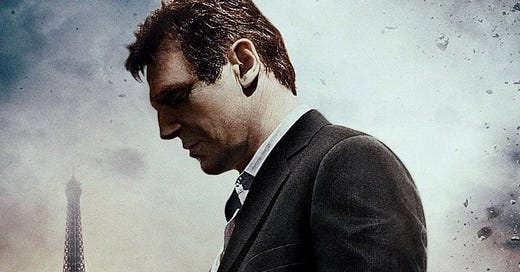


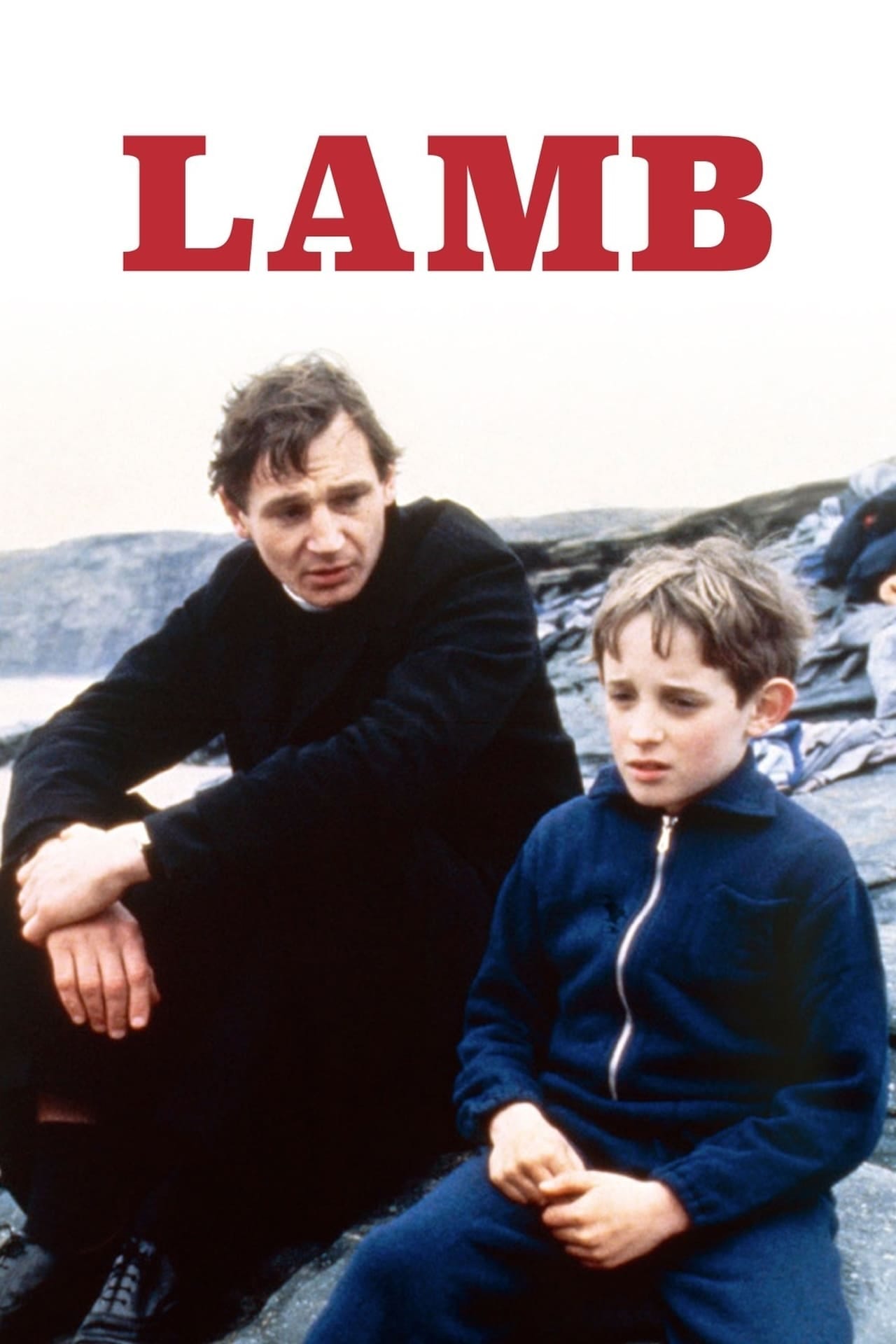

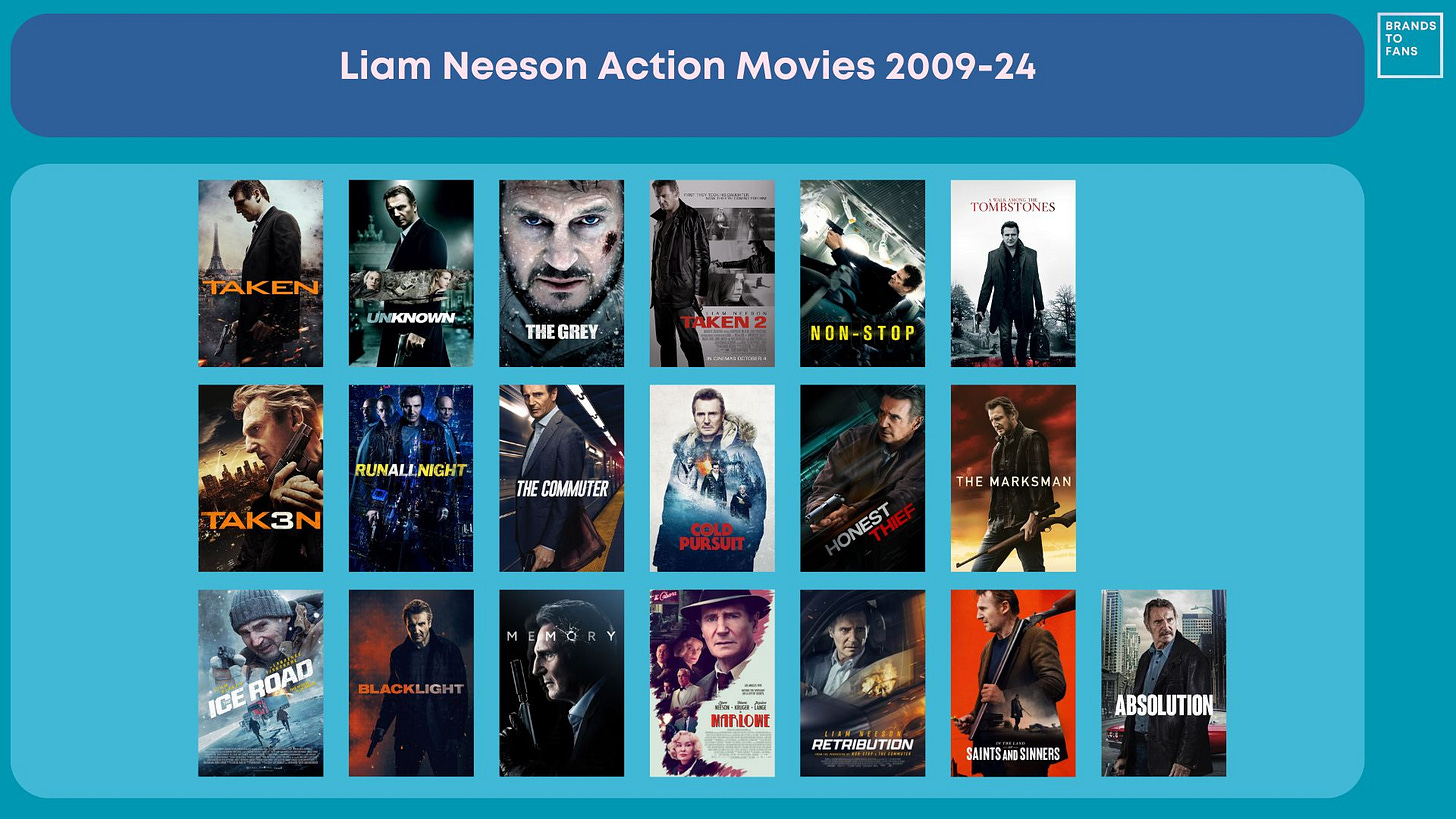
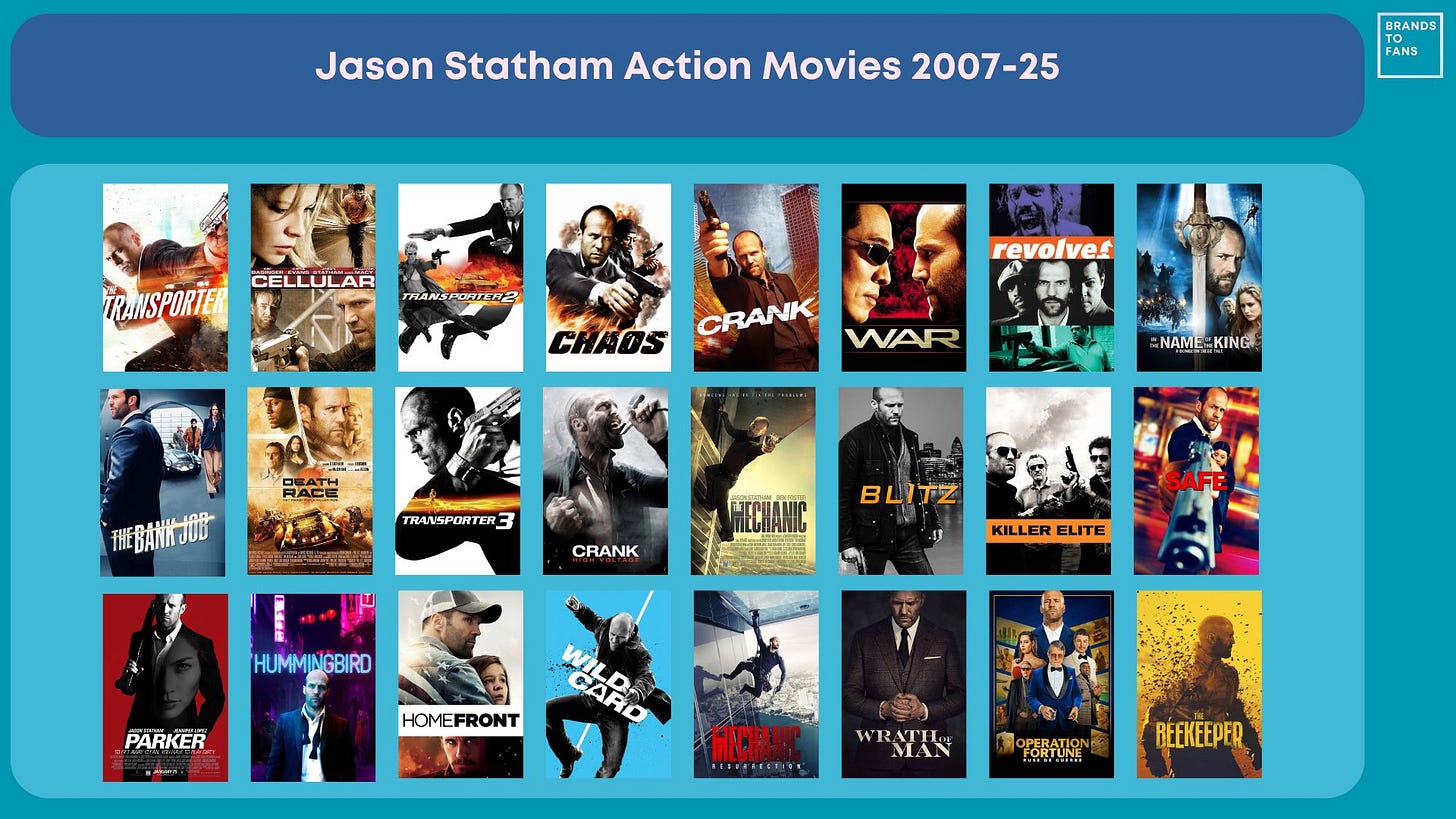
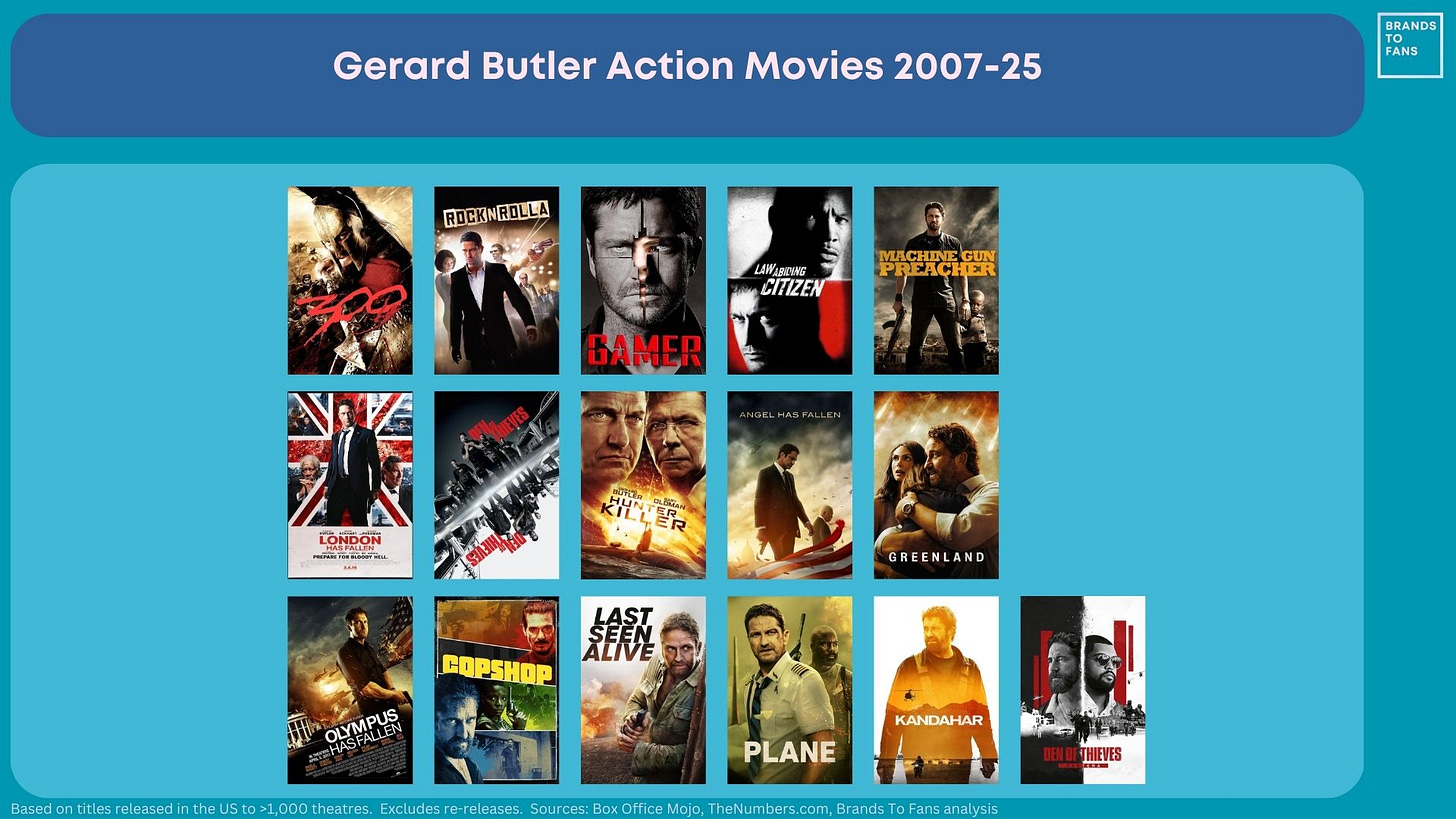
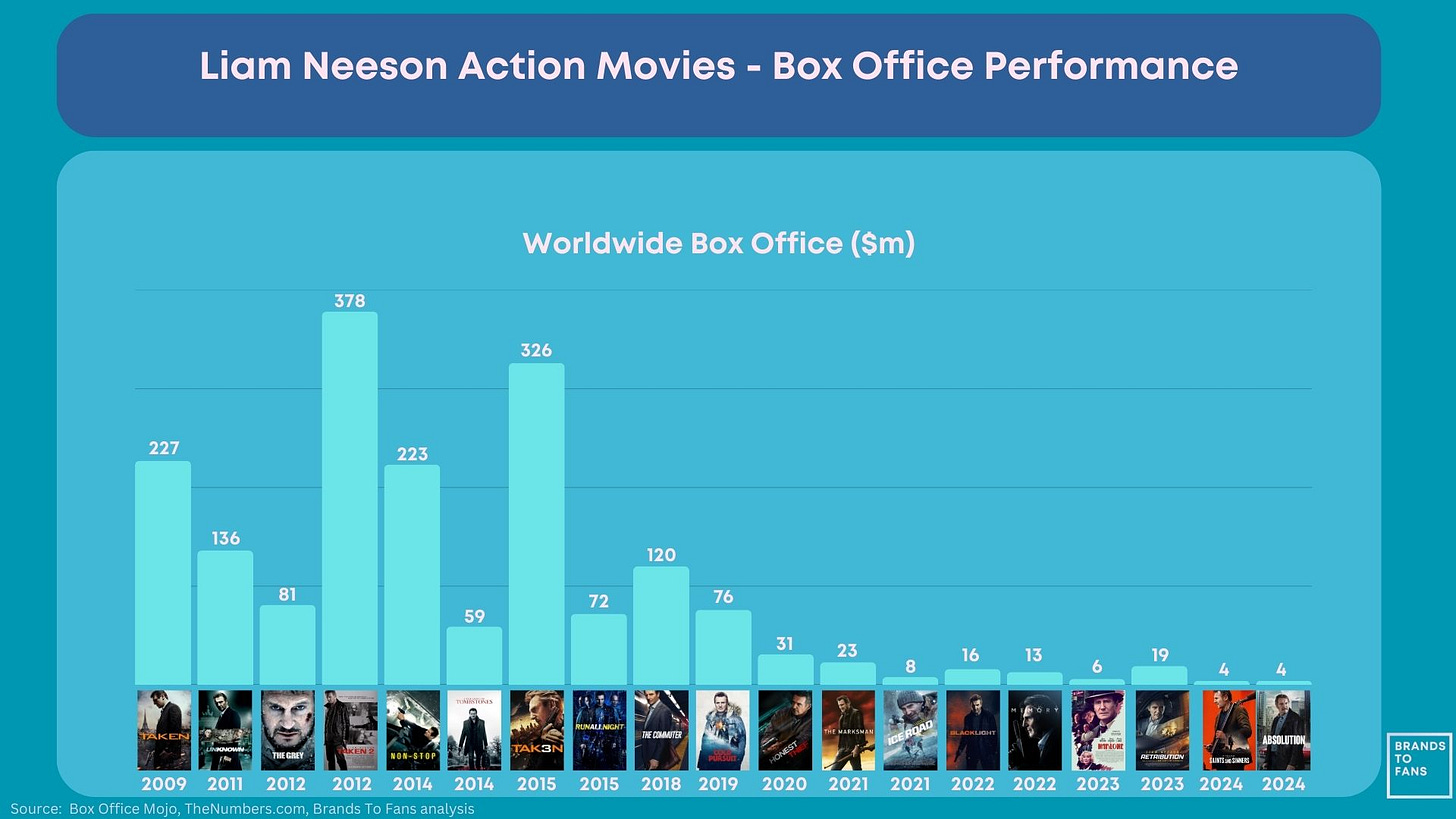
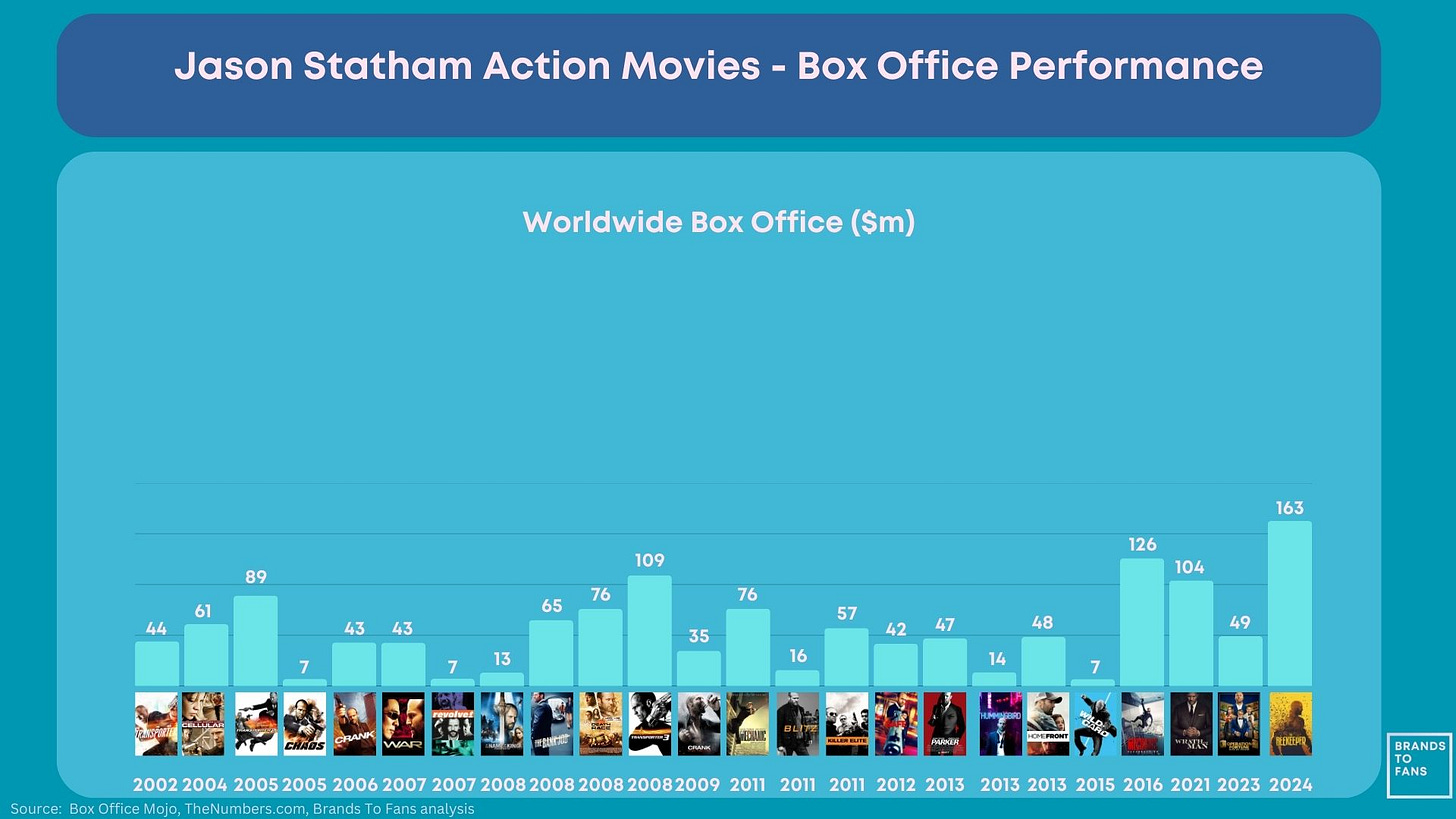


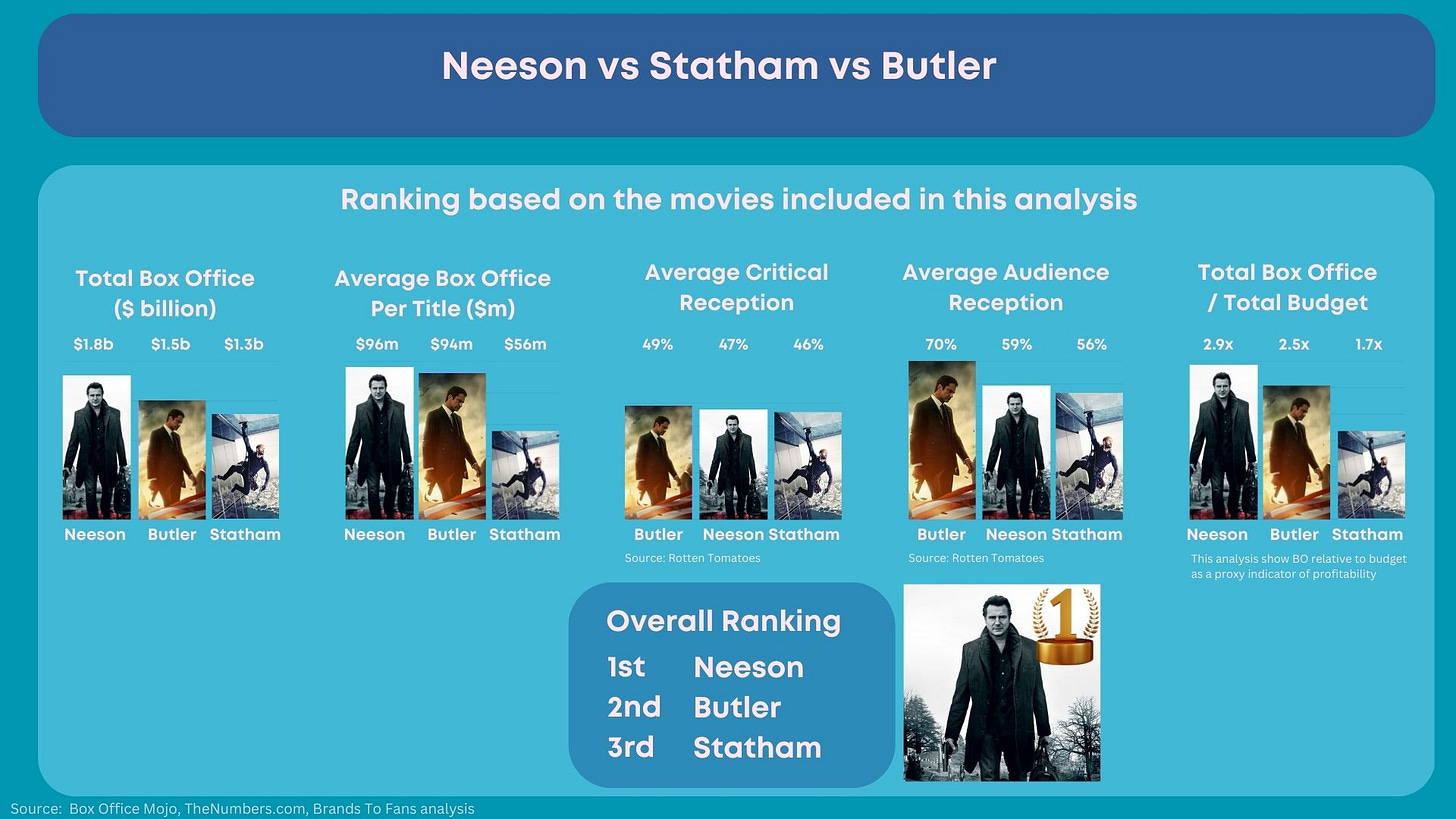
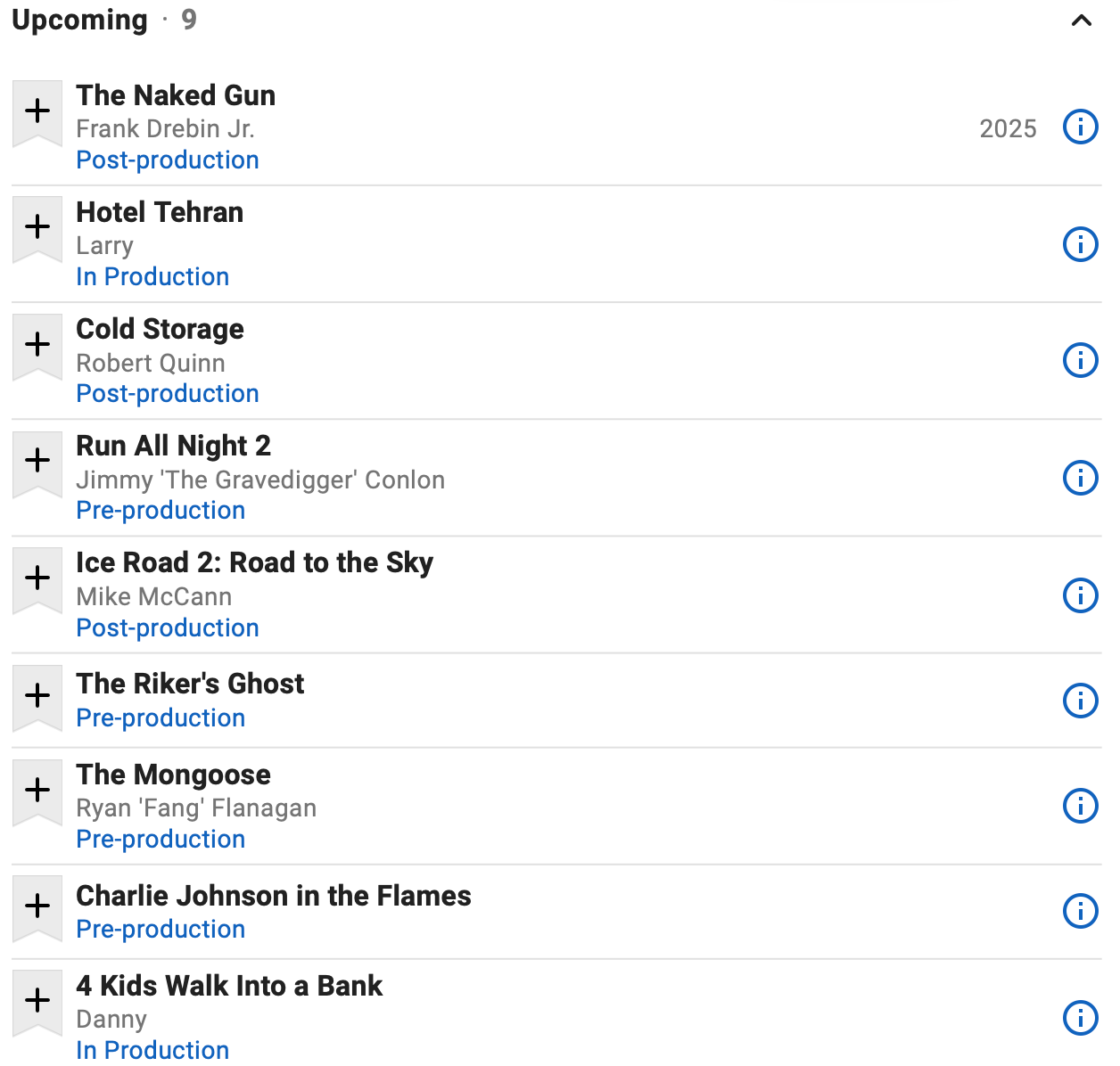
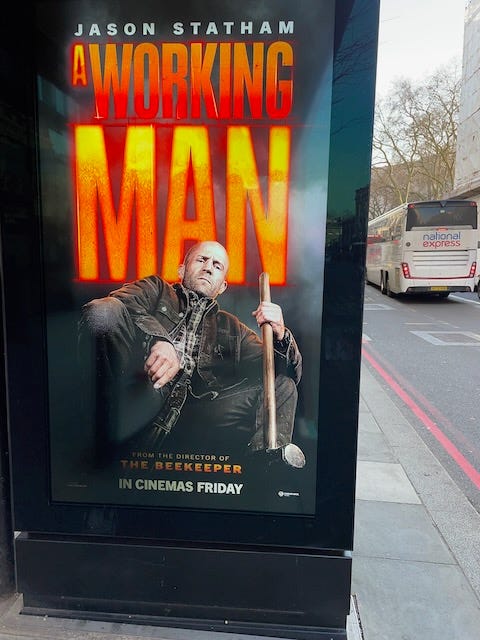
An offline comment I received on this post from a media exec:
"This is essentially V2.0. The original genre smackdown was Segal Vs Snipes Vs Van Damme. Budgets were a little smaller but that was 20 years ago but the genre and model much the same - talent led IP where the talent could be as much as 50% of the budget. In those days we used to call the genre Fading action heroes"
Nice piece. I liked how you broke everything down.